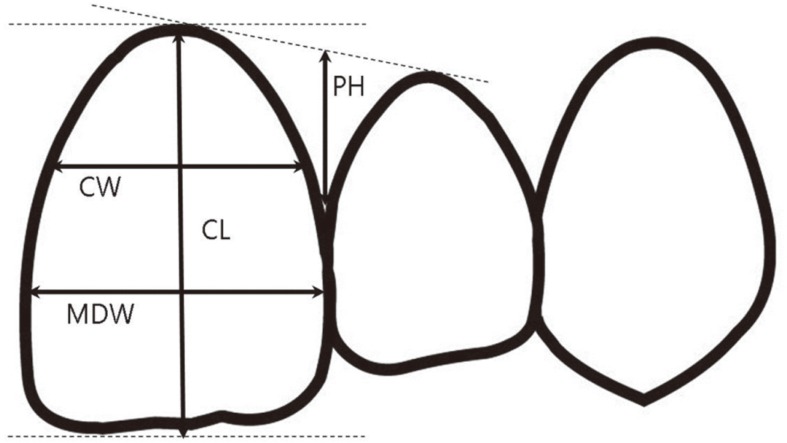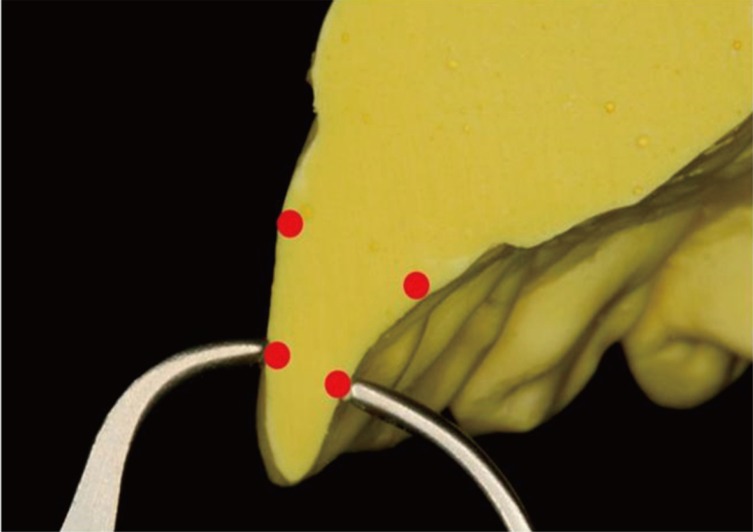J Adv Prosthodont.
2017 Aug;9(4):315-320. 10.4047/jap.2017.9.4.315.
Analysis of crown size and morphology, and gingival shape in the maxillary anterior dentition in Korean young adults
- Affiliations
-
- 1Department of Prosthodontics, Graduate School of Dentistry, Kyung Hee University, Seoul, Republic of Korea.
- 2Department of Biomaterials & Prosthodontics, Kyung Hee University Hospital at Gangdong, School of Dentistry, Kyung Hee University, Seoul, Republic of Korea. sbykmw@yahoo.co.kr romeoni@hanmail.net
- KMID: 2398080
- DOI: http://doi.org/10.4047/jap.2017.9.4.315
Abstract
- PURPOSE
The aim of this investigation was to analyze the dimensions of clinical crowns and to classify the crown and the gingival type in the anterior teeth in Korean young adults.
MATERIALS AND METHODS
Casts were obtained from 50 subjects ranging in age from 24 to 32. Measurements of length and width were made on the casts using a pair of digital calipers on the entire dentition. Crown thickness and papilla height were also measured and MDW/CL (mesiodistal width to clinical length) and CW/CL (cervical width to clinical length) ratios of the maxillary anterior teeth were calculated. The K-clustering method was used for CW/CL to classify the anterior tooth shape into three groups (tapered, ovoid, and square), and one-way analysis of variance and Duncan's post-hoc comparison were used to evaluate statistical significance between the groups. Pearson's correlation analysis was performed between tooth shape and papillary height (PH) to demonstrate the correlation between tooth shape and gingival morphological characteristics.
RESULTS
The average length of the maxillary central incisors was 9.89 mm; the mesio-distal width was 8.54 mm; and the ratio of width/length was 0.86 in Korean young adults. The average bucco-palatal thickness of the central incisor was 3.14 mm at the incisal 1/3 aspect. Ovoid type was the most common tooth shape (48%), followed by square type (29%) and taper type (23%) in the central incisors of Korean young adults. Tooth shape and gingival type were correlated with each other.
CONCLUSION
New reference data were established for tooth size in Korean young adults and the data show several patterns of tooth shape and gingival type. Clinicians should diagnose and treat based on these characteristics for better results in the Korean population.
Keyword
Figure
Cited by 1 articles
-
Full mouth rehabilitation of a severely worn dentition using intraoral scanner and the CAD/CAM double scanning technique
Se-Na Yoon, Jung-Suk Han, In-Sung Yeo, Hyung-In Yoon
J Korean Acad Prosthodont. 2020;58(1):67-76. doi: 10.4047/jkap.2020.58.1.67.
Reference
-
1. Jeong DK, Kim KH, Park JM, Chang MT, Kim HS. A relationship between interdental papilla existence and the distance from contact point to interdental alveolar crest in the maxillary anterior dentition of Korean adults. J Korean Acad Periodontol. 2001; 31:633–640.
Article2. Kim SH, Chung HJ. The relationship between clinical crown form and gingival feature in upper anterior region. J Korean Acad Periodontol. 2005; 35:761–776.
Article3. Garn SM, Lewis AB, Kerewsky RS. Sex difference in tooth size. J Dent Res. 1964; 43:306. PMID: 14128945.
Article4. Oh SC. A study on morphology and size of clinical crown of permanent mandibular molar in Korean adult. J Korean Acad Prosthodont. 1999; 37:242–255.5. Olsson M, Lindhe J, Marinello CP. On the relationship between crown form and clinical features of the gingiva in adolescents. J Clin Periodontol. 1993; 20:570–577. PMID: 7691897.
Article6. Olsson M, Lindhe J. Periodontal characteristics in individuals with varying form of the upper central incisors. J Clin Periodontol. 1991; 18:78–82. PMID: 2045523.
Article7. Müller HP, Heinecke A, Schaller N, Eger T. Masticatory mucosa in subjects with different periodontal phenotypes. J Clin Periodontol. 2000; 27:621–626. PMID: 10983595.
Article8. Townsend GC, Brown T. Heritability of permanent tooth size. Am J Phys Anthropol. 1978; 49:497–504. PMID: 736106.
Article9. Nam JH, Lee KS. A study of mandibular dental arch form of the Korean with normal occlusion. Korean J Orthod. 1996; 26:535–546.10. Paik KS, Kim KM. A statistical study on morphology and size of the maxillary cenrtral incisor in Korean adult. Korean J Oral Anat. 1988; 12:37–42.11. Lundström A. Genetic aspects of variation in tooth width based on asymmetry and twin studies. Hereditas. 1967; 57:403–410. PMID: 5626432.12. Gillen RJ, Schwartz RS, Hilton TJ, Evans DB. An analysis of selected normative tooth proportions. Int J Prosthodont. 1994; 7:410–417. PMID: 7802908.13. Morrow LA, Robbins JW, Jones DL, Wilson NH. Clinical crown length changes from age 12-19 years: a longitudinal study. J Dent. 2000; 28:469–473. PMID: 10960749.14. Al-Khatib AR, Rajion ZA, Masudi SM, Hassan R, Anderson PJ, Townsend GC. Tooth size and dental arch dimensions: a stereophotogrammetric study in Southeast Asian Malays. Orthod Craniofac Res. 2011; 14:243–253. PMID: 22008304.
Article15. Corruccini RS. Molar cusp-size variability in relation to odontogenesis in hominoid primates. Arch Oral Biol. 1979; 24:633–634. PMID: 295199.
Article16. Garn SM, Lewis AB, Swindler DR, Kerewsky RS. Genetic control of sexual dimorphism in tooth size. J Dent Res. 1967; 46:963–972. PMID: 5234039.
Article17. Jensen E, Kai-Jen Yen P, Moorrees CF, Thomsen SO. Mesiodistal crown diameters of the deciduous and permanent teeth in individuals. J Dent Res. 1957; 36:39–47. PMID: 13398501.
Article18. Sofaer JA, Chung CS, Niswander JD, Runck DW. Developmental interaction, size and agenesis among permanent maxillary incisors. Hum Biol. 1971; 43:36–45. PMID: 5090314.19. Reid C, van Reenen JF, Groeneveld HT. Tooth size and the Carabelli trait. Am J Phys Anthropol. 1991; 84:427–432. PMID: 2053617.
Article20. Oh SC, Jung JH. Morphology and size of clinical crown of prrmanent upper anterior teeth in Korean adult. J Korean Acad Stomatognathic Funct Occlusion. 2001; 17:37–42.21. Müller HP, Eger T. Masticatory mucosa and periodontal phenotype: a review. Int J Periodontics Restorative Dent. 2002; 22:172–183. PMID: 12019713.22. Sterrett JD, Oliver T, Robinson F, Fortson W, Knaak B, Russell CM. Width/length ratios of normal clinical crowns of the maxillary anterior dentition in man. J Clin Periodontol. 1999; 26:153–157. PMID: 10100040.
Article23. Dawson PE. Determining the determinants of occlusion. Int J Periodontics Restorative Dent. 1983; 3:8–21.24. Chiche GJ, Pinault A. Replacement of deficient crowns. J Esthet Dent. 1993; 5:193–199. PMID: 8037969.
Article25. Wheeler RC. Complete crown form and the periodontium. J Prosthet. 1961; 11:722–734.
Article26. Ericsson I, Lindhe J. Recession in sites with inadequate width of the keratinized gingiva. An experimental study in the dog. J Clin Periodontol. 1984; 11:95–103. PMID: 6199377.27. An CH, Heo SR, Cho IH, Kim HS. Clinical features of the gingiva according to maxillary anterior teeth form in adult. J Korean Acad Periodontol. 2005; 35:359–369.
Article
- Full Text Links
- Actions
-
Cited
- CITED
-
- Close
- Share
- Similar articles
-
- Perception of maxillary anterior esthetics by dental professionals and lay people and topographical tooth-gingiva interface
- Comparison of Crown Shape and Amount of Tooth Reduction for Primary Anterior Prefabricated Crowns
- A Morphometric Study of Primary Anterior Zirconia Crowns in Korean Tooth Models
- A Study on Morphology and Size of the Maxillary Lateral Incisor in Korean Adult
- Esthetic prosthesis for a patient with the maxillary diastema: a case report



